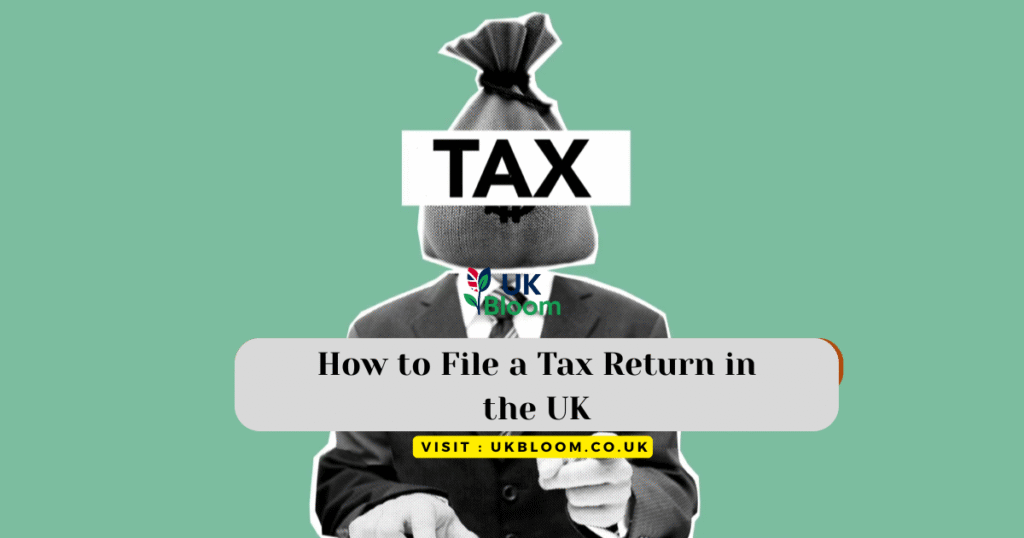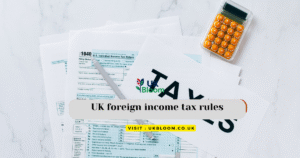Filing your tax return can feel daunting—especially if you’re self-employed, a landlord, or have foreign income. At UK Bloom, we simplify the process for newcomers and residents alike. How to File a Tax Return in the UK this 2025 guide walks you through everything from registration to penalties, including important deadlines and useful resources.
Who Needs to File a Tax Return?
You must file a Self Assessment tax return with HMRC if in the last tax year (6 April to 5 April), you:
- Were self-employed or a sole trader and earned more than £1,000
- Were a partner in a business partnership
- Earned £100,000 or more in total income
- Had untaxed income, such as rental income, dividends, or foreign income
- Claimed certain tax reliefs
- Are a trustee or a company director with untaxed income
HMRC will not automatically contact you if you’re required to file. It’s your responsibility to register and file on time.
Table of Contents
When Is the UK Tax Return Deadline?
| Type | Deadline (Tax Year 2024–2025) |
|---|---|
| Register for Self Assessment | 5 October 2025 |
| Submit paper return | 31 October 2025 |
| Submit online return | 31 January 2026 |
| Pay your tax bill | 31 January 2026 |
Late filing or payment leads to automatic penalties, even if you owe no tax.
How to Register for Self-Assessment with HMRC
If you’ve never filed before, register by 5 October 2025 at the latest.
For the Self-Employed:
- Visit the official GOV.UK Self Assessment registration page.
- Select “Register if you’re self-employed”.
- Provide your full name, address, date of birth, National Insurance number, and business details.
- HMRC will post your Unique Taxpayer Reference (UTR) within 10 working days (21 if abroad).
- Set up a Government Gateway ID.
For Others (e.g., Landlords, Directors, Foreign Income):
Use the SA1 form to notify HMRC that you need to file a return.
Documents You’ll Need to File
Gather these before you start your return:
- UTR number
- National Insurance number
- Government Gateway login
- Income details (P60, P45, invoices, bank statements)
- Expenses and receipts (if self-employed)
- Pension contributions and student loan statements
- Interest/dividends from savings or investments
- Details of rental income and allowable expenses
- Foreign income records and any double taxation relief documents
How to File a Tax Return in the UK
Filing online is the fastest and most efficient method. Here’s how:
Step-by-Step Process:
- Log in to your HMRC online account.
- Click on Self Assessment > File your tax return.
- Answer HMRC’s questions to determine which sections apply to you.
- Enter income and expenses under the correct headings:
- Employment: Add details from P60 or P45
- Self-employment: Enter income and allowable expenses
- Property income: Add rental income, mortgage interest, repairs
- Claim tax reliefs or allowances if applicable
- Review your return thoroughly
- Submit and note the confirmation reference
🧾 HMRC will immediately calculate how much tax you owe or are due as a refund.
How to File by Paper (and Why to Avoid It)
Paper returns must be filed by 31 October. Use form SA100, available to download or order from GOV.UK.
However, filing by paper is discouraged due to:
- Delays in processing
- No instant tax calculation
- No real-time error checking
Unless you are unable to file online due to disability or lack of internet access, go digital.
What Happens After You File
Once submitted:
- HMRC issues a tax calculation and summary
- You must pay any owed tax by 31 January
- If your tax bill exceeds £1,000, you may have to make Payments on Account (advance payments for the next tax year)
- If due a refund, it’s usually paid within 5 working days
Track all activity through your online HMRC account.
Penalties for Missing the Deadline
Filing or paying late triggers automatic penalties, even if no tax is owed.
| Delay | Penalty |
|---|---|
| 1 day late | £100 fixed penalty |
| 3 months late | Additional £10 per day (up to £900) |
| 6 months late | Further £300 or 5% of tax due |
| 12 months late | Extra £300 or up to 100% of tax due |
Late payments attract 3.25% interest (2025 rate) on top of fines.
Help for New Arrivals in the UK
If you’ve recently moved to the UK, you’re likely unfamiliar with the HMRC process. Here are some tips:
- Use the UK Bloom Moving to the UK Guide
- Set up a UK bank account to manage tax payments
- Apply for your National Insurance Number as early as possible
- Read our full article on UK Income Tax Bands and Thresholds for 2025
You can also call the HMRC helpline on 0300 200 3310 for real-time support.
Useful Internal and External Links
Internal Resources:
- Income Tax Calculator (UK)
- UK Self-Employed Visa Guide
- UK Residency and Tax Guide
- Childcare and Schooling Costs
- Skilled Worker Visa Guide
External Resources:
- Register for Self Assessment – GOV.UK
- File your tax return – HMRC
- Tax Return Deadlines – GOV.UK
- National Insurance – GOV.UK
- Foreign Income and Tax – GOV.UK
Frequently Asked Questions
Can I file a UK tax return without a UTR number?
No. You must have a Unique Taxpayer Reference before filing. Apply early to avoid delays.
What if I made a mistake on my tax return?
You can amend your return within 12 months of the filing deadline. Log into your HMRC account and choose the ‘Amend Return’ option.
Do I need to file a return if I’m employed full-time?
Not unless you have additional untaxed income or meet the criteria under Self Assessment.
What happens if I miss the 5 October registration deadline?
You can still register late, but may face penalties or delays. Always inform HMRC as soon as possible.
Disclaimer
This article is for informational purposes only. Always consult the UK Home Office, HMRC, or a licensed tax advisor for personalised guidance. Rules and thresholds are subject to change.
© 2025 ukbloom.co.uk. All rights reserved. You may not reproduce this article without credit and backlink to ukbloom.co.uk. Unauthorised duplication will result in copyright infringement.






